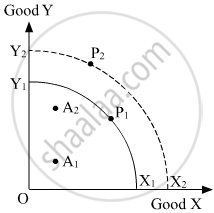Advertisements
Advertisements
Question
Choose the correct answer from given options
In the given figure X1Y1 and X2Y2 are Production Possibility Curves in two different periods T1 and T2 respectively for Good X and Good Y. A1 and A2 represent actual outputs and P1 and P2 represent potential outputs respectively in the two times periods.

The change in actual output of Goods X and Y over the two periods would be represented by a movement from __________.
Options
A2 to P2
A1 to P2
P1 to A2
A1 to A2
Solution
The change in actual output of Goods X and Y over the two periods would be represented by movement from A1 to A2.
Hence, the correct answer is A1 to A2.
APPEARS IN
RELATED QUESTIONS
Demand for a good is termed inelastic through the expenditure approach when if (choose the correct alternative)
a) Price of good falls, expenditure on it rises
b) Price of the good falls, expenditure in it falls
c) Price of the good falls, expenditure on it remains unchanged
d) Price of the good rises, expenditure in it falls
If due to fall in the price of good X, demand for good Y rises, the two goods are : (Choose the correct alternative)
a. Substitutes
b. Complements
c. Not related
d. Competitive
(b) less elastic demand
(c) zero elastic demand
(d) unitary elastic demand
Write Explanatory answer.
State and explain the law of demand with its exception.
Fill in the blank with appropriate alternatives given below:
Market demand is an aggregate of purchasing by _________ buyers.
State whether the following statement is TRUE and FALSE
Desire means demand.
Define or explain the following concept:
Derived demand
Give reason or explain the following statement.
Increase in demand indicates a rightward shift in the demand curve.
Distinguish between Desire and Demand.
Answer the following question:
Elaborate the law of demand, with the help of a hypothetical schedule.
In case of ______ supply curve is a vertical straight line parallel to Y-axis.
Are the concepts of demand for domestic goods and domestic demand for goods the same?
Which of the following have elastic demand?
Identify the two cost curves which start from the same point on the Y-axis.
Aggregate demand can be decreased by:
Which of the following is correct?
Read the following news report and answer the Q.97-Q.100 on the basis of the same:
The quantity of a commodity that a consumer is willing to buy and is able to afford, given the prices of goods and the consumer's tastes and preferences is called demand for the commodity. Whenever one or more of these variables change, the quantity of the good Chosen by the consumer is likely to change as well. The relation between the consumer's optimal choice of the quantity of a good and its price is very important and this relation is called the demand function. Thus, the consumer's demand function for a good gives the amount of the good that the consumer chooses at different levels of its price when the other things remain unchanged.
Assertion: The income of the consumers remains unchanged
Reason: Commodity should be a normal good.
Select the correct alternative from the following.
Read the case study and answer the questions 97 to 100:
The Coca-Cola Company is an American multinational beverage company, with its headquarters in Atlanta, Georgia. The first company that conducted its operation in the soft drink industry was Coca-Cola. It is the world's largest non-alcoholic beverage company serving more than 1.8 billion consumers daily in more than 200 countries. It has a portfolio of more than 3,500 (more than 800 no or low-calorie) products. However, the company is best known for its flagship product Coca-Cola which was originally intended to be a patented medicine invented in 1886 by pharmacist John Smith Pemberton in Columbus, Georgia. The Coca-Cola products can be termed as normal goods and in August 2019 Coca-Cola introduced a new product into the market, that is, zero sugar where the demand has increased for the product in the market.
According to the council of the Australian Food Technology Association and Institute of Food Science and Technology, the Australian nonalcoholic beverages industry has been growing steadily, with a 2.3 percent increase in overall production in the year 2000 which amounts to 2.25 billion liters. However, in the re~ent years, sales of customary carbonated soft drinks have dropped as more and more customers become health conscious and move away from high-calorie sugary drinks. Soft Carbonated drinks. and other alcohol-free beverage manufacturers have also sensed the effects of intensifying competition from private-label soft drink makers. Nevertheless, sales of greater value energy and sports drinks have driven profit generation in the industry.
What has happened to the demand of zero sugar carbonated drinks?
Which of the following statements is true?
